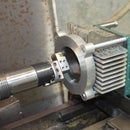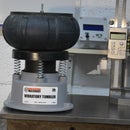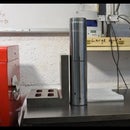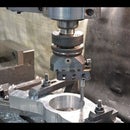Introduction: Manual Thread Tapping Machine
Sometimes a project gets made because the right materials and/or components appear, Such was the case with this hand tapping device, the construction of which forms the basis of this post. Except for the Irwin tap holders everything came from the scrap box (I prefer to call it the rainy day collection)
For quite a long time a hand tapper as featured here has been on my rainy day to do list but it had never risen to the status of do it NOW, That is until out of the blue it occurred to me that parts of my old Russian photo enlarger (from pre-digital camera days) provided most of the bits that I would otherwise have to make. I knew that it would come in handy one rainy day.
There are many ways to tap a thread but here we are concerned with hand tapping. The biggest problem with hand tapping is holding the tap square to the workpiece. There are various devices which can be made or bought to help in this area and the type of tapping machine described here is but one. It is suitable for many tapping jobs but not all. Often machines like this are made with a fixed frame which limits the height of the workpiece. I wanted a device which would handle a much larger range of jobs and that is what the old enlarger support offered.
The final step in this instructable links to a video of the process and the reader is advised to watch that.
I have entered this post in the "Trash to treasure" contest so if you like it please vote for it.
Step 1: Materials and Tools
The only "bought in" item for this project was the Irwin Hanson 3/8" drivetap holders pictured above. They come in pairs for small and larger taps. I got mine from this Amazon link
As I mentioned in the intro. everything else was what I had laying around. Of course everyone who wants to make a similar tool will have different stuff in their scrap bin and so the detail design can easily be adjusted to suit what you have. Even if all material had to be bought the cost should still be reasonable.
The project has three main parts as follows:
1. The base. Comprised of some angle iron and a piece of steel plate.
2. The frame. I used parts from an old photo enlarger. There must be plenty on the usual "for sale" websites, if you have not got one. Alternatively a simple clamp could be fabricated from steel tube or machined from aluminium.
3. The shaft or spindle and bushing. I had a short length of Thomson shaft 1" diameter which was ideal. Thomson shaft is hardened and ground on the outer surface but is softer in the middle so it can be drilled. Unhardened steel shaft would do fine unless you were using the tapper so much that wear would be a problem.
Tools needed
Welder - I used MIG for the base and the add-on piece for the enlarger. TIG or stick would do just as well.
Lathe - used to make the sleeve for a bronze bush.
Milling machine - This is useful but not essential. I used it to true up the base because my starting piece was so out of true.
Drill press, vertical milling machine or pistol drill - for drilling a few holes.
Any tool suitable for cutting steel for the base. I used an angle grinder with a thin cutoff blade but a bandsaw, plasma cutter, laser, waterjet, milling machine or hacksaw would be fine also.
Usual hand tools.
Step 2: Starting the Base
The starting pieces for the base are shown in the photos.
I went digging for some angle iron for the base but that had all been used except for this old piece of frame work which seemed about the right size 265 mm x 240 mm (10.5" x 9.5"). I think that this might have been something that my son used for welding practice.
A few minutes with a cutoff blade in an angle grinder soon had it looking more useful.
The table top was cut from a piece of 6 mm thick steel plate that had been left on the side of a road. It had been used to cover a pot hole and was discarded after repair. It had a slight bow in it which some brute force straightened out. Top and bottom of the base were later machined flat and true so the remaining bow was unimportant in the final analysis.
The plate was 300 mm (12") wide and I did not want to cut it down to the 265 mm of the frame so it will over hang 35 mm to give more work piece real estate. I cut a piece off at 240 mm to match the width of the frame.
Step 3: Making the Base
Firstly, I used an angle grinder to clean up the angle iron frame and then milled off what would be the top to provide a flat surface for the table plate, The plate was tack welded to the frame, more welding would only have caused more distortion. In order to get the maximum working throat I added a small extension to the back of the table for the mounting foot of the enlarger piece.
Three feet and support pieces for the overhang were welded next. The feet were faced off in the mill then the base was flipped and the whole table surface milled flat.
Chatter is always a problem to some extent when milling such a piece and the finish on the table is not perfect but it is perfectly adequate for this type of tool.
Step 4: Making the Spindle
The purpose of the spindle assembly is to hold the 3/8" square drive Irwin tap holders square to the table and to allow vertical and rotational motion.
From some scrap tooling, left over from a previous life, I had a length of Thomson shaft and a nice fitting bronze bush. Note that part of the shaft is waisted down, this is a relic of its previous usage and serves no function on the tapper. Neither does it cause a problem.
I had a broken 3/8" drive bit with a round shank, I bored an interference sized hole in the shaft and pressed the bit in place.
At the top end of the shaft I pressed on another piece from the scrap box, which just happened to fit with no extra work. I saw the larger diameter as an easy way for a support spring to do its job. This piece was cross drilled for the winding handle.
Step 5: The Enlarger Parts
The first picture shows the parts of the enlarger useful for this project.
There is a support casting which bolts to my base plate, this holds the vertical column. The working bracket has a height adjustment handle and a clamping screw to hold position. These were the features that make it attractive for me. It allows easy adjustment for different height work pieces.
I had to turn the main bracket upside-down to be able to lower it sufficiently to tap thin work pieces.
Step 6: Addition to the Enlarger
The function of the enlarger assembly is ultimately to hold the spindle bush in accurate alignment to the base at an appropriate distance from the column and allow operation of the spindle. Fortunately the loads placed on the bush are small and so a heavy structure is not required.
I wanted a minimum of a 200 mm (~8") throat and the enlarger bracket was too short. I made a simple extension piece from some 1.5 mm (16 g) steel sheet and a piece of steel tubing. I bored the tube slightly oversize for the bronze bush. I knew that welding would distort the tube and I didn't want the bush distorted as well when fitted, so the plan was that the oversize tube would allow easy fitting of the bush which would be fixed in place with Loctite. That worked out fine as planned. This steel fabrication was bolted to the aluminium enlarger bracket. The photos show this better than words can.
Step 7: Finishing Up
Initially I used a load balancing spring as shown in the first photo. That was a mistake because the spring force increases as the spindle moves down. It did not give an intuitive feel. I removed the spring soon after completion and I have used it since without any load balancing. In the future on another rainy day I will add a counter weight system as used on some commercial units.
The second photo shows two alternative handle lengths to allow sensitive feel for small taps and more torque for large ones. two flats are milled on the top of the cross bar for clamping with the grub screw.
Step 8: Summary
I have created from the junk box a tool which largely satisfies my target. The only disappointment was that the spring did not work out well. It was a simpler solution than using a counterweight system, but I will eventually make a counterweight. I know that works great,
I also have two reversing tapping heads for a mill or drill press which do a good job but I tend to use this manual tapper more now, simply because it is so convenient and quick.
The throat is 200 mm and the workpiece thickness range is Zero to 275 mm (~11") with 50 mm (2") movement on the spindle.
Some aspects of a build like this are better shown in a video and you can watch the movie above.
If you like this post and video please like, share and subscribe to my Youtube channel and my Instructables.
I have entered this post in the "Trash to treasure" contest so if you like it please vote for it.





